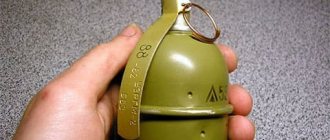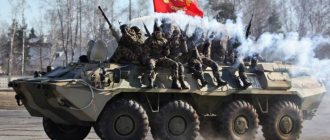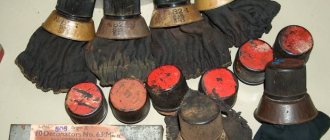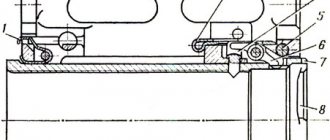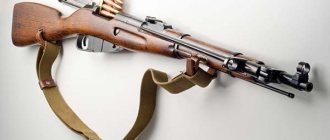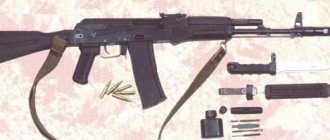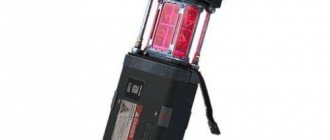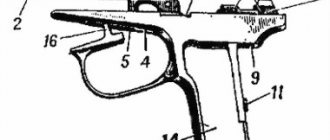Usage
To use a grenade, you need to straighten the antennae of the safety pin, take the grenade in your right hand so that your fingers press the lever to the body. Before throwing a grenade, insert the index finger of your left hand into the pin ring and pull it out. Experienced instructors claim that a left-handed person can hold and throw a grenade with his left without any problems, and pull the pin with his right. The grenade can continue to remain in the hand for as long as desired until the lever is released, the firing pin cannot break the primer (in principle, if the need to throw a grenade has disappeared and the pin has not been thrown out, it can be inserted back (without releasing the lever!); after bending tendrils of pomegranate checks are suitable for normal storage). [ source not specified 890 days
] After choosing the moment of the throw and the target, throw a grenade at the target. At this moment, the lever will rotate under the influence of the striker spring, releasing the striker, and fly off to the side. The drummer will puncture the capsule and after 3.2 - 4.2 seconds an explosion will occur.
The grenade is designed to destroy manpower and unarmored vehicles. The damaging factors are the direct high-explosive action of the explosive and the fragments formed when the metal shell of the grenade is destroyed.
General provisions
During classes and exercises, grenades are thrown at the command of the commander, and in battle - depending on the situation, either on command or independently.
When throwing live grenades during classes and exercises, observe safety measures to prevent damage to the thrower and his neighbors. After throwing an offensive grenade while moving, without stopping, prepare to fire and continue moving. After throwing a defensive and anti-tank grenade, immediately take cover, and after the explosion, quickly prepare to fire or start moving. When operating on armored personnel carriers, after the explosion, the thrower is prepared to fire through the loophole.
Throwing hand grenades in combat is carried out from various positions: standing, kneeling, lying down, as well as while moving from an armored personnel carrier and on foot (offensive only).
To throw a grenade, you need to choose a place and position that ensures free flight of the grenade to the target (there are no obstacles on the way: tree branches, tall grass, wires, etc.).
The grenade must be thrown energetically, giving it the most favorable flight path. thirty
Project evaluation
In general, this example of an anti-personnel grenade should be considered successful. The F-1 has stood the test of time, has a simple, reliable design, is technologically advanced and easy to manufacture, and effectively copes with the tasks assigned to this type of weapon. It is natural that the shortcomings of the project flow from its advantages.
Advantages
Due to its simple and reliable design, the F-1 grenade has been in service for about 70 years without significant changes and will probably not be removed from service for a long time. The advantages that ensure such a long service life are as follows:
- A body of natural crushing, from which destructive elements are successfully formed even when the metal jacket is damaged.
- The remote igniter has a relatively simple design and is highly reliable.
- The all-metal monolithic body is easy to manufacture and can be manufactured at almost any industrial enterprise, even non-specialized ones. The body material - steel cast iron - is very cheap.
- The simplicity of the internal design allows, in war conditions, to use any available explosive instead of standard TNT.
- The power of the explosion of this grenade is such that, when thrown into a well, it literally “throws out” all the objects in it, including water. This property is useful when storming various mines and tunnels of medium diameter. If the enemy hiding behind a turn, corner or other obstacle at a distance of closer than 30 meters from the explosion is not hit by shrapnel, then he is almost guaranteed to be killed by a sharp pneumatic shock caused by the blast wave. The attacker is prohibited from being in the tunnel, as he himself may get hurt.
- The remote detonation action allows you to throw a grenade towards the enemy, using the rebound from walls, ceilings and various obstacles.
Flaws
The disadvantages of this grenade are mainly due to the obsolescence of its design, and not to design flaws. These include:
- Low efficiency of formation of fragments when crushing the body. Most of the body mass (up to 60%) forms fragments that are too small to kill. At the same time, several too large fragments are often formed, increasing the dangerous distance and reducing the number of fragments of the optimal size. The corrugation of the hull, which is generally random in nature, cannot ensure the formation of fragments of a satisfactory shape and their optimal distribution over the mass (the very idea of the formation of fragments of a predictable size due to the corrugation of the hull turned out to be not entirely correct).
- The remote fuse does not lead to an explosion when it hits the target, but fires after some time (this is a property of any
remote fuse, not just the UZRG). - The grenade is relatively heavy, which somewhat reduces the maximum throw range.


